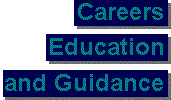
Education Index


 |
Main Index Education Index |
 |
 |
 |
| |||||||||||||||||||||
| CEG in Schools Careers education and guidance is one of the cross-curricular themes within the National Curriculum. All schools are required to have a careers education policy stating how the topic is taught within the school. Schools are free to design their own careers timetable according to their resources and their needs. In addition to time-tabled careers lessons, careers education can also be taught through other subject areas or Personal and Social Education (PSE). | |
| The Early Years In the early stages careers education starts with an awareness of the world of work.The idea of people having different jobs for different purposes is discussed. At this stage no direct teaching about careers is carried out though children do ask questions about who does what and why. See: Key Stage 1 and Key Stage 2 | |
| The Middle Years In the middle years there is a growing understanding about the importance of career choices. Although most children are undecided at this stage about what they want to do after they leave school, they are starting to think about their subject likes and dislikes. Pupils may be involved in joint curriculum projects with local industries or mini-enterprise schemes. See: Key Stage 2 and Key Stage 3 | |
| From 13+ In the later stages schools can choose how to deliver their Careers programme and there are a number of variations. Generally CEG is taught or coordinated by careers staff through:
| |
| Index |  |
[ Key Stage 1 and 2 | Key Stage 3 | Key Stage 4 ] [ A-Z Glossary | Careers Issues ] |
| Top | ||
|
|